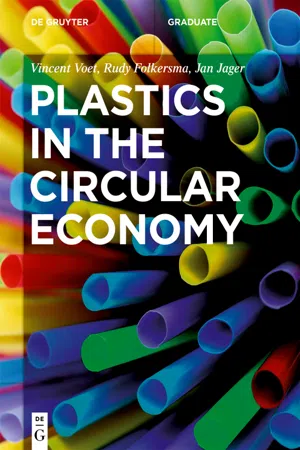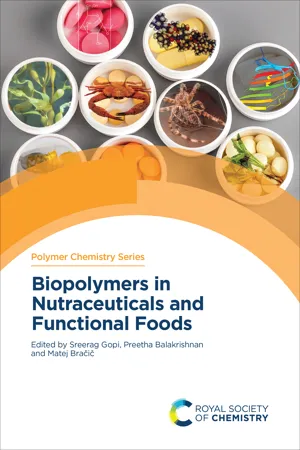Biological Sciences
Polymer
A polymer is a large molecule composed of repeating structural units called monomers. In biological systems, polymers play essential roles in the structure and function of cells and organisms. Examples of biological polymers include proteins, nucleic acids (DNA and RNA), and carbohydrates. These macromolecules are vital for processes such as cell signaling, energy storage, and genetic information transfer.
Written by Perlego with AI-assistance
Related key terms
12 Key excerpts on "Polymer"
- eBook - ePub
Polymer Fillers and Stiffening Agents
Applications and Non-traditional Alternatives
- Chris Defonseka(Author)
- 2020(Publication Date)
- De Gruyter(Publisher)
The word ‘plastics’ is derived from the Greek word ‘plastikos’. In general, a plastic can be defined as a material that is pliable and capable of being shaped by temperature and pressure. Plastics are based on Polymers derived from the Greek word ‘Polymeros’, with ‘poly’ meaning many, and meros meaning basic units. Polymers are also called resins in the commercial world, which is not really correct because resins are gum-like substances.Polymer chemistry is a multidisciplinary science that deals with chemical synthesis and chemical properties of Polymers, which are considered to be macromolecules. Polymer chemists study the large complex molecules (Polymers) that are built from smaller (sometimes repeating) units. They study how these smaller building blocks (monomers) were combined to create useful newer materials with specific characteristics. This is done by manipulating the molecular structure of the monomer/Polymers used, the composition of the monomer/Polymers combination, and applying chemical and processing technology that can, to a large extent, affect the properties of the final product. Polymer chemists are unique within the chemistry and scientific community because of their special knowledge and understanding of the relationships between Polymer structures and their properties, spanning from the molecular to the macroscopic state.Although most Polymer chemists work on applied research and development of Polymers, there are opportunities for fundamental research (mainly in universities, government laboratories, and industrial labs) on theory of Polymers in solid and liquid states, on the synthesis of new Polymer structures, and also on the mechanical, electronic, optical, biological and other properties of those new Polymers are supposed to have. Polymer chemistry and fundamental Polymer research are inherently interdisciplinary, spanning chemistry, physics, engineering, economics and even biology.2.2 What are Polymers?
A Polymer is a large molecule (macromolecule) composed of repeating basic structural units. These subunits are typically connected by covalent chemical bonds. Although the term ‘Polymer’ generally refers to plastics, it encompasses a larger class of compounds, comprising natural and synthetic materials with a wide variety of properties. Because of the extraordinary range of Polymeric materials, they have essential and vital roles in everyday life of people. They broadly range from the very familiar synthetic plastics and elastomers to natural bioPolymers such as nucleic acids and proteins, which are essential for life. - eBook - ePub
- Vincent Voet, Jan Jager, Rudy Folkersma(Authors)
- 2021(Publication Date)
- De Gruyter(Publisher)
2 Introduction to Polymer science2.1 Classification
The success of plastics can be attributed to their low costs and wide range of properties that can be changed by tweaking the macromolecular structure. This unique structure–property relationship will receive specific attention in the remainder of this chapter. We will start by discussing various ways to categorize Polymer materials.The term Polymer is derived from the Greek wordsπ o λ(polus = “many”) andυ ´ςμ(meros = “part”). Polymers can be defined as large molecules, sometimes referred to as macromolecules, composed of a large number of repeating units. The exact number required to meet the definition of a Polymer depends on the size and chemical structure, but a good rule of thumb is at least 50 repeating units. Smaller molecules are named oligomers, which translates to “few parts”.ε ´ρ o ςThe building blocks that form a Polymer molecule are called monomers, literally meaning “one part”. Monomers can undergo Polymerization, in which they react together to form a Polymer chain or network structure. Polymerizations are the subject of Section 2.3 .Considering the definition of a Polymer, a tremendous amount of possibilities arise: flexible or stiff Polymers, Polymers derived from nature or those made in factories, Polymers that absorb or repel water, Polymers applied in airplanes or used in clothing, etc. To create some order, Polymers are classified based on various categories, as displayed in Fig. 2.1 .Figure 2.1 Classification of Polymers based on origin, chemistry, (physical) properties, Polymerization route, and application.2.1.1 Origin
A wide variety of macromolecules is present in nature. Polysaccharides like starch and cellulose are formed in plants, while proteins such as silk and casein can be found in animals. Polynucleotides, known as DNA and RNA, play a crucial role in storing, coding, expressing, and regulating genetic information. While some natural Polymers can be used directly as technical materials when harvested, other Polymers need to be modified. For example, cellulose can be transformed into cellophane films or rayon and viscose fibers via the xanthate process. The hydroxyl groups in cellulose are modified in a basic environment, and cellulose is regenerated from viscose using acid. Also, technical rubber is produced by crosslinking latex from rubber trees via a process named vulcanization. Macromolecules made by chemically treating natural Polymers are named semi-synthetic Polymers [7 - eBook - ePub
- Bengt Kronberg, Krister Holmberg, Bjorn Lindman(Authors)
- 2014(Publication Date)
- Wiley(Publisher)
9 Polymers in SolutionA Polymer is a large molecule, a macromolecule, built up of smaller chemical units, monomers. A natural division of the science of Polymers is into biological and nonbiological macromolecules. Biological macromolecules are, for example, proteins, nucleic acids, and polysaccharides while nonbiological macromolecules include the common plastics and adhesives. This chapter deals mainly with water-soluble Polymers.Polymer Properties are Governed by the Choice of Monomers
Synthetic Polymers are synthesized by the Polymerization of monomers. The monomers in the Polymerization constitute the repeat units, for example, acrylic acid is Polymerized into poly(acrylic acid). A Polymer can either be linear, branched, or cross-linked, as depicted in Figure 9.1 a. It is important to characterize the category a certain Polymer belongs to in order to understand its solution behavior, since it differs considerably between the three categories. When only one type of monomer is used the Polymer is termed homoPolymer. If the Polymer is synthesized with more than one kind of monomer, it is termed a coPolymer. The monomer units in a coPolymer can be (i) randomly distributed, (ii) distributed in blocks, or (iii) distributed such that one of the monomers is grafted in chains onto the backbone of the other monomer chain (Figure 9.1 b). Also, the solution properties and the surface chemical properties are very sensitive to which category a coPolymer belongs. Some of the structures shown in Figure 9.1 b are strikingly surface active. Surface active Polymers are dealt with specifically in Chapter 10 - eBook - ePub
Vegetable Oil-Based Polymers
Properties, Processing and Applications
- Niranjan Karak(Author)
- 2012(Publication Date)
- Woodhead Publishing(Publisher)
Polymers are composed of large molecules with a high molecular weight, unlike fine chemicals or small molecular compounds. These macromolecules are formed by covalent links of large numbers of simple repeating units with identical constituents, where the addition or subtraction of a few such units does not change the properties. The term ‘Polymer’ is a combination of two Greek words: ‘poly’ meaning ‘many’ and ‘meros’ meaning ‘parts’ or ‘units’. A Polymer is thus the sum of many parts or units. ‘Polymerisation’ is the process of forming Polymers from their respective reactive units.The small molecules which form repeating units are known as monomers. Monomers typically react in the presence of a catalyst or initiator to form a Polymer. The number of repeating units present in each Polymer chain is known as the ‘degree of Polymerisation’ (DP) and is used to determine the molecular weight of the Polymer by the following formula:molecular weight = molecular mass of repeating unit X ‘DP’The high molecular weight of Polymers is a result of the high DP, given the number of monomers in each chain.In a Polymerisation process, different Polymer molecules may have different numbers of repeating units in their chains and hence the chain lengths are different, even under the same set of reaction conditions in the same batch. This is because the number of reactions involved in the formation of each Polymer molecule is very high, so controlling the number of repeating units in different molecules is extremely difficult. The chain length of one molecule will differ from other molecules in the same Polymer. Thus the number of repeating units varies from chain to chain, even within the same batch of Polymers, so only the average number is taken and the molecular weight is expressed as the average molecular weight.BioPolymers are found in animal and plant sources. Natural Polymers include protein-based fibres such as wool and silk (mainly polyamide), carbohydrate fibres such as flax and cotton (mainly cellulose) as well as in tree saps which produce amber and latex (mainly hydrocarbon). The term ‘Polymer’ was first coined by Berzelius in 1833. However, it was only in the 1920s that the concept of a Polymer as a long sequence of repeating units linked by covalent bonds, was presented by H. Staudinger. (Nobel prize winner for chemistry, 1953).1 - Ram I. Mahato(Author)
- 2004(Publication Date)
- CRC Press(Publisher)
1 Structure, Properties, and Characterization of Polymeric Biomaterials Anjan Nan and Hamidreza Ghandehari 1.1 INTRODUCTION Biomaterials is a term used to indicate materials that constitute the basic framework of medical implants, extracorporeal devices and disposables utilized in medicine, surgery, dentistry, veterinary, as well as in other aspects of medical care. Biomaterials can be natural or synthetic in origin. They are used in a variety of ways from being carrier molecules for delivery of bioactive agents (small molecular weight drugs, proteins, peptides, oligonucleotides, and genes) or as whole or part of systems that augment or replace tissues or organs. The term “biomaterials” make them unique from other classes of materials in that they are required to meet special biocompatibility criteria (as discussed in Chapter 6) for acceptance in the biological system. Polymeric constructs are a major component of biomaterials. Polymers are macromolecules consisting of multiple repeating units or monomer residues linked together usually by covalent linkages. End-groups are the structural units that terminate Polymer chains. Polymers containing reactive end-groups to allow for further chemical modification are called telechelic Polymers. The monomers in Polymeric systems can be linked together in various ways to give rise to linear chains, branched or three-dimensional cross-linked networks (Figure 1.1). A linear Polymer has no branching. A typical example is poly(ethylene glycol) (PEG) (Table 1.1). Linear Polymers can have pendent groups associated with them. Example of linear Polymeric systems with pendent side-groups are N- (2-hydroxypropyl)methacrylamide (HPMA) coPolymers (Table 1.1). Branched Polymers are those in which the molecules have been formed by branching as opposed to a linear Polymer. A Polymer with a high degree of three-dimensional tree-like branching starting from a core is called a dendrimer- eBook - ePub
- Alan Cooper(Author)
- 2015(Publication Date)
- Royal Society of Chemistry(Publisher)
1
Biological Molecules
You don’t need to know any biology in order to study biological molecules, but it does help to have some background.Aims This chapter will briefly review the bare bones of biological (macro)molecules. By the end, and together with your previous knowledge and some background reading, you should be able to:- Describe the basic chemical structures of polypeptides, polynucleotides, fats, lipids, and carbohydrates
- Explain what is meant by the primary, secondary, tertiary and quaternary structure of proteins
- Describe the behaviour of fats, lipids and detergents in water
- Explain the anomalous properties of liquid water
- Recall the fundamentals of acid–base equilibrium
1.1 Introduction
This book is mainly about the experimental methods used to understand the physical properties and function of the molecules that make up living systems.These molecules—proteins, polynucleotides, polysaccharides, lipids—are not necessarily any different from molecules we study in other branches of chemistry. But there are some additional factors, arising from their biological origin, which we need to be aware of.- Biological macromolecules are large molecules formed from many smaller units and are (usually) Polymers of precise length and specific sequence.
- They (usually) fold or associate into specific conformational assemblies stabilized by non-covalent interactions.
- This (usually) happens in water.
- The molecules are the (usually) successful outcomes of biological evolution.
It is this last point that makes things so exciting for the biophysical chemist. The molecules we see today are the results of countless random (more or less) experiments over millions of years during which living systems have evolved to take advantage of subtle principles of physical chemistry that we barely yet understand. By studying such systems we can learn much about physical chemistry in general, with potential for applications in other areas. - eBook - ePub
- Atsushi Ikai(Author)
- 2016(Publication Date)
- Elsevier(Publisher)
5.1. Polymers in the Biological World
Biological structures are made of Polymeric substances such as proteins, polysaccharides, and nucleic acids. Some examples of such natural Polymers follow. I. ProteinsStructural proteins : collagen (cartilage), elastin (lung), keratin (hair, skin), etc. crystalline proteins (lens), adhesive proteins (cell adhesion), fibroin (silk), etc.Enzymes : proteases, nucleases, glycosidases, lipases, esterases, etc. dehydrogenases, oxygenases, carboxylases, synthetases, transferases, etc.Antibodies : IgA (immunoglobulin A), IgD, IgE, IgG, IgM.Hormones : growth hormones, insulin, glucagon, somatostatin, etc.Transport and storage proteins : serum albumin, lipoproteins, ferritin, transferrin, hemoglobin, myoglobin, etc.Receptors and channels : rhodopsin (vision), insulin receptor, sodium channel, potassium channel, anion channel, etc.Nucleo proteins : histones, protamines, telomerases, etc.Membrane proteins : glycophorins, cadherins, integrins, stomatin, Band 3, etc.Matrix proteins : laminin, fibronectin, vitronectin, etc.II. PolysaccharidesAmylose and amylopectin : Polymers of glucose (α- D-linkage)Cellulose : Polymers of glucose (β-D-linkage)Chitin : Polymers of N -acetyl glucosamineMannan : Polymers of mannoseGalactan : Polymers of galactoseIII. Nucleic acids DNA RNAProteins are most often cited in this book for two reasons. First, proteins are the workhorse of life with amazingly wide variety of biological functions and this has attracted many researchers. The second reason is more personal in that the research interests of the author and coauthors of this book center mainly around elucidating the physical properties of proteins of various kinds. In this chapter, a general nature of Polymeric molecules is summarized as a help for reading scientific papers on biological macromolecules. - eBook - ePub
Bioinspiration and Biomimicry in Chemistry
Reverse-Engineering Nature
- Gerhard Swiegers, Gerhard Swiegers(Authors)
- 2012(Publication Date)
- Wiley(Publisher)
Chapter 11: Biomimetic Principles in Macromolecular Science Wolfgang H. Binder, Marlen Schunack, Florian Herbst and Bhanuprathap Pulamagatta11.1 Introduction
And God said, “Let the earth bring forth living creatures according to their kinds—livestock and creeping things and beasts of the earth according to their kinds.” And it was so. —Genesis 1:24As a theologist would preach, so a scientist would soberly state that, while less prosaic, evolution has never been able to separate living and nonliving matter. When structural features of a living cell are subjected to close inspection, Polymeric matter of all kinds can be seen acting together on a surprisingly tiny scale; using bioPolymers for ordering, self-assembly, recognition, and reproduction processes.Thus, the linear bioPolymers called proteins are the main structural elements of enzymes and structural tissue, using only 21 amino acids as repetitive building blocks (known as monomers in synthetic Polymer science). It needs only the shuffling of these 21 monomeric units by God (or evolution) to build all of the essential helices, folded - Sreerag Gopi, Preetha Balakrishnan, Matej Brai, Sreerag Gopi, Preetha Balakrishnan, Matej Brai(Authors)
- 2022(Publication Date)
- Royal Society of Chemistry(Publisher)
89 The RNA nucleotide consists of a ribose sugar connected to a phosphate group and a nucleobase.Figure 1.11 Molecular structure of nucleic acids.1.3.4 Polymer Backbone
The term “Polymer” refers to macromolecules that are made up of a high number of repeating basic units (monomers) that are chemically linked. These monomers regulate interactions between the Polymer's chain and determine its overall properties. Due to Polymers having a wide range of morphologies, the Polymer structure can be described in a variety of ways (Figure 1.12 ). Previously, it has been mentioned that the backbone arrangement can come in many forms, including random, block, grafted, and alternating forms. On top of that, more sophisticated structures such as branching, ladders, crosslinked, ring-shaped, star-shaped, and dendrimeric also can be found along the backbone of some Polymers. Polymers can be homoPolymers, which are composed of a single monomer or heteroPolymers, which are a combination of different monomers. Further classification of heteroPolymers can be done according to the monomers’ arrangement in the Polymer backbone. The backbone arrangement can come in many forms, including random, block, and alternating forms, in addition to more sophisticated structures such as branching, ladders, crosslinked, ring-shaped, star-shaped, and dendrimeric.90- eBook - ePub
- Marek W. Urban, Marek W. Urban(Authors)
- 2011(Publication Date)
- Wiley-VCH(Publisher)
2 Biological- and Field-Responsive Polymers: Expanding Potential in Smart Materials Debashish Roy, Jennifer N. Cambre, and Brent S. Sumerlin 2.1 IntroductionMany of the most important substances in living systems are macromolecules that vary according to their surrounding environment. Synthetic (co)Polymers can gain similar adaptive behavior such that their utility goes beyond providing structural support to allow active participation in a dynamic sense. Incorporating multiple copies of functional groups readily amenable to a change in character (e.g., charge, polarity, solvency) along a Polymer backbone causes relatively minor changes in chemical structure to be synergistically amplified, which leads to transformations in macroscopic material properties. The “response” of a Polymer can be defined in many ways. Responsive Polymers in solution are typically classified as those that change their individual chain dimensions/size, secondary structure, solubility, or the degree of intermolecular association. In most cases, the physical or chemical event that causes these responses is limited to the formation or destruction of secondary forces (hydrogen bonding, hydrophobic effects, electrostatic interactions, etc.), simple reactions (e.g., acid–base reactions) of moieties pendant to the Polymer backbone, and/or osmotic pressure differentials that result from such phenomena. In other systems, a response includes more significant alterations in the Polymeric structure. This chapter includes both concepts with emphasis on those that hold promise in the areas of biomedical, sensing, and electronics applications.Interest in stimuli-responsive Polymers has persisted over many decades, and a great deal of work has been dedicated to devising examples of environmentally sensitive macromolecules that can be crafted into new smart materials. However, the overwhelming majority of reports in the literature describing stimuli-responsive Polymers are dedicated to macromolecular systems sensitive to a few common stimuli, typically changes in pH, temperature, and electrolyte concentration. We aim at highlighting recent results and future trends of biological- and field-responsive Polymers that have not yet been exploited to a similar extent. Many of the topics represent opportunities for making advances in biomedical fields, due to their specificity and the ability to respond to stimuli that are inherently present in biological systems. Synthetic Polymers that adapt in response to specific interactions with biomacromolecules and small molecules associated with healthy or diseased states (e.g., glucose) may facilitate the application of smart Polymers in drug delivery, diagnostics, sensing, separations, and so on. Additionally, it is often advantageous to capitalize on a stimulus specifically applied from an external source so that the location and rate of response can be easily adjusted. The ability to apply these types of stimuli in a noninvasive manner facilitates applications in vivo - eBook - ePub
Mass Spectrometry in Structural Biology and Biophysics
Architecture, Dynamics, and Interaction of Biomolecules
- Igor A. Kaltashov, Stephen J. Eyles, Dominic M. Desiderio, Nico M. Nibbering(Authors)
- 2012(Publication Date)
- Wiley(Publisher)
Of great interest is the possibility of producing Polymeric materials synthetically that either mimic their biological analogues, or indeed improve on their properties in some way. Following the pioneering work by Staudinger (131, 132) and Carothers et al. (133), the macromolecular nature of synthetic Polymers has become a commonly accepted concept. Although a detailed consideration of synthetic Polymers is beyond the scope of this book, we will briefly discuss several classes of Polymers whose behavior is important from the biophysical point of view. The first class is a rapidly growing group of the so-called “bioinspired” Polymers that are designed to possess certain structural or functional features of biological macromolecules (134–136). Fibroin, mentioned earlier, has been a particularly popular target for such design due to its superior mechanical properties (125), with nylon (Fig. 8.14) representing perhaps the first successful attempt to imitate a bioPolymer. Figure 8.14 Examples of synthetic Polymers. Polyamidoamine = PAMAM. While the design of synthetic analogues of silk proteins remain the focal point of extensive research efforts (137), strategies that employ genetic engineering to mix the modules of the natural protein in specific proportions to attain the desired properties are rapidly gaining popularity (139). An important issue here is how the mechanical properties of the Polymers are modulated by conformational transitions. An example of such conformational change is a helix-to-sheet transition in the amorphous segments of the dragline silk proteins, which is often invoked to explain its superior expandability characteristics - Masoud Mozafari, Narendra Pal Singh Chauhan(Authors)
- 2019(Publication Date)
- Elsevier(Publisher)
The development of functional Polymers has still been an area of immense interest and great importance in biomedical applications. As such, a broad range of approaches for Polymerization as well as bioconjugation has been evolved in different contexts. The greatest influence coming out of such efforts is evident as new therapeutic/diagnostic (theranostic) capabilities. The aim of this chapter is to illustrate the part played by functional Polymers in emerging biomedical applications, and fast-growing subfields such as tissue engineering, drug delivery, and gene delivery.Keywords
Biomedical engineering; functionalization; Polymers1.1 Introduction
Functional Polymers find an increasing popularity both in academia and in industry. They are macromolecules with unique features and applications [1 ,2] . The features of this class of materials mostly depend on the presence of chemical functional groups that vary from those of the backbone chains, for instance, polar or ionic functional groups on hydrocarbon backbones or hydrophobic groups on polar Polymer chains. Polymer backbones are selected due to their properties ranging from mechanical strength and flexibility to chemical stability and processability [2] . Functionalization of the bulk Polymer results in chemical heterogeneity, which, in turn, gives rise to many advantages, namely improved reactivity, phase separation, enhanced compatibility, or association. In addition, the possibility of functional Polymers to create self-assemblies or supramolecular structures is another benefit. In response to chemical or physical stimuli, the formation or dissociation of the self-assemblies can lead to “smart” materials [3] . The majority of functional Polymers are found on simple linear backbones, including chain-end (telechelic), in-chain, block or graft structures. Nevertheless, functional Polymers with particular topologies or architectures have drawn much attention [4 ,5] . These consist of three-dimensional Polymers, for example, stars, hyperbranched Polymers [6] , or dendrimers [7] (treelike structures) (Fig. 1.1
Learn about this page
Index pages curate the most relevant extracts from our library of academic textbooks. They’ve been created using an in-house natural language model (NLM), each adding context and meaning to key research topics.











